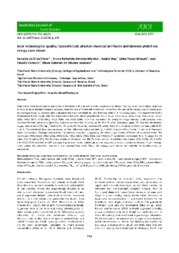Juice technological quality, lignocellulosic physical-chemical attributes and biomass yield from energy cane clones.
Juice technological quality, lignocellulosic physical-chemical attributes and biomass yield from energy cane clones.
Summary: Abstract: Originating from backcrossing generations between wild and commercial sugarcane varieties, ?energy cane? technology promises to revolutionize global energetic scenario, once full use of feedstock is allowed. Therefore, the aim of this study was to assess juice technological quality, lignocellulosic physical-chemical composition, and biomass yield of nine energy cane. The experiment had a randomized block design with five replications for each clone (treatment) (VX12-1659, VX12-1658, VX12-1356, VX12-1191, VX12-1022, VX12-0277, VX12-0201, VX12-0180, and VX12-0046) with five replicates. Following to tillage harvest, stalk samples were assessed for total soluble solids (ºBrix; % juice), sucrose (Pol; % juice), purity (Prt; % juice), reducing sugars (RS; % juice), theoretical sugars recoverable (TSR; kg t-1 stalks), Pol (% cane), RS (% cane), moisture (% cane), fibers (Fib; % cane), and dry biomass yield (DBY; t ha-1). The obtained data was subjected to the following statistical tests (p < 0.05): Shapiro?Wilk, Fisher, Tukey, and Pearson?s linear correlation. Findings revealed null hypothesis rejection, suggesting the clones significantly affected all assessed traits. The individuals VX12-1659, VX12-1658, VX12-1356, VX12-1191, VX12-1022, and VX12-0277 exhibited the highest °Brix (% juice), Pol (% juice), Prt (% juice), TSR, Pol (% cane), moisture (% cane), and Fib (% cane) values. In addition, the clones VX12-1659, VX12-1658, and VX12-1356 resulted in DBY averages higher than other individuals of the population. In fact, all clones showed Type II energy cane typical characteristics due to a low sucrose/fiber ratio. Thus, the energy cane clones are suitable for bioelectricity co-generation.
Publication year: 2019
Types of publication: Journal article
Unit: Embrapa Environment
Observation
Some of Embrapa's publications are published as ePub files. To read them, use or download one of the following free software options to your computer or mobile device. Android: Google Play Books; IOS: iBooks; Windows and Linux: Calibre.
Access other publications
Access the Agricultural Research Database (BDPA) to consult Embrapa's full library collection and records.
Visit Embrapa Bookstore to purchase books and other publications sold by Embrapa.

